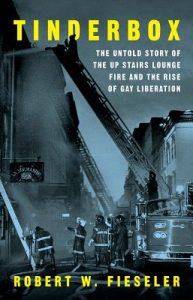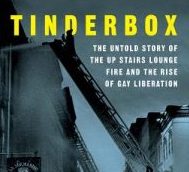 Tinderbox: The Untold Story of the Up Stairs Lounge
Tinderbox: The Untold Story of the Up Stairs Lounge
Fire and The Rise of Gay Liberation
by Robert W. Fieseler
Liveright Publishing
343 pages, $26.95
THE SUBTITLE of Robert W. Fieseler’s new book about the fire in a New Orleans gay bar that killed 32 people on June 24, 1973, is “The Untold Story,” but in fact there have been several renditions of this story already: John Townsend’s Let The Faggots Burn (2011), Clayton Delery-Edwards’ The Up Stairs Lounge Arson (2014), Frank Perez’ In Exile (2012), a history of gay bars in New Orleans, and Robert Camina’s 2017 documentary Upstairs Inferno. But evidently Fieseler felt there was more to tell, or he would not have spent several years interviewing survivors and searching through archives before piecing the story together in his own, very moving book.
The structure reminds one of Thornton Wilder’s classic novel The Bridge of San Luis Rey, in which the individual fates of a disparate group of people united by a bridge collapse are described. Fieseler opens by introducing many of the people whom we know will end up at the Sunday afternoon Beer Bust in the Up Stairs Lounge, a not very glamorous bar just on the edge of the French Quarter, in fact down the street from the Hotel Monteleone, which—ironically, or predictably, given the incredible layers of history in the Quarter—is where the gay literary festival Saints and Sinners is held every spring. As in so many books with a large cast, you find yourself going back to the opening chapters to be reminded of who some of them are, but after a while you find yourself following the few who interest you most.
In 1971, informal surveys “estimated that there were about 75,000 homosexuals living in New Orleans,” Fieseler writes, “but fewer than 1,000 could be called ‘out’ by twenty-first century standards.” In 1972, according to Bob Damron’s Address Book, there were two gay bathhouses, 24 gay and lesbian bars, and three gay-friendly restaurants. In short, it was a very gay city. It was also an intensely homophobic one. In 1972, three sheriff’s deputies in suburban Jefferson Parish were fired for merely associating with “a known homosexual”—their wives’ hairdresser. At the time of the Up Stairs Lounge fire, one of the rites of passages for fraternity boys at Tulane was “rolling a queer”—which meant going down to the Quarter, finding a homosexual, robbing and beating him up, and returning to campus. One of these victims, a visiting Mexican tour guide named Fernando Rios, was beaten so badly that he died; and when the fraternity boys were acquitted of his murder—the defense argued that Rios’ skull was unnaturally delicate—the courtroom erupted in applause. (Clayton Delery has written a book about this case titled Out for Queer Blood.)
Fernando Rios was murdered by presumably straight frat boys, but the Up Stairs Lounge fire was intentionally set by a gay hustler who’d been kicked out of the bar earlier for punching another hustler for stealing a john he was working on. The irony is that the Up Stairs Lounge was not a hustler bar. Nor was it the Cafe Lafitte in Exile, where the A-list went. It was an unpretentious, friendly dive where a mixed group of homosexuals and their friends literally found refuge; where before closing the patrons would stand and sing “United We Stand” before going back to their deeply closeted lives in a city where you could get fired from your job for being gay. It was a place where the New Orleans branch of the newly minted Metropolitan Community Church, as small as it was, could meet, in lieu of a church of their own—which is why, after the fire, the founder of the MCC, Troy Perry, flew immediately from Los Angeles to New Orleans to help.
The description of the fire, pieced together bit by bit from interviews with survivors and archival research, is so painstakingly done that it’s hard to read. AIDS, in the next decade, was a horrifying shock; but in this fire there was no time to process one’s fate or come to terms with death, much less bargain with it, or try out medicines; it all happened in an instant—a fireball so powerful it was like a flamethrower once somebody made the mistake of opening the doors. The response to it, however, was just what the response would be to AIDS a decade later: the newspapers would not even use the word “homosexual” or “gay,” and in two days it was off the front page. The mayor failed to acknowledge what had happened, while men who’d lost their lovers in the catastrophe had to go to work the next day and remain silent while co-workers made jokes about the tragedy (“Did you hear the one about the flaming queens?”). The religious establishment was unsympathetic to requests for use of their churches for a memorial service. The board of a nearby Lutheran church told Paul Breton, a member of the MCC in Washington, D.C., who’d flown to New Orleans to contact the comparative black congregation well outside the French Quarter, since “they are more tolerant of aliens there.” Only the United Methodist Church in the Quarter finally came through and provided space for a service.
Attempts to obtain coverage in the press and create a memorial for the victims of the fire met with little success despite the efforts of Troy Perry. Even the owner of the Up Stairs Lounge didn’t want the closet to be opened. Gay people in New Orleans were accustomed to an arrangement with the authorities that allowed people to be gay behind closed doors. One could open a gay bar or even take a prominent position in society (like Clay Shaw, the man Jim Garrison destroyed in his ill-fated attempt to prove a conspiracy theory in the JFK assassination), but one could not claim a homosexual identity in public. “Live and let live” was the arrangement the gay population had with the city—so that some even resented Troy Perry’s attempt to advance the cause of gay rights. So life went on much as it had before the fire. Buddy Rasmussen, the bartender who saved so many people by leading them to safety but who lost his own lover, ended up tending bar at the Post Office, a new bar opened by the owner of the Up Stairs Lounge a year and a half after the fire (until one night he quit in the middle of his shift and moved to Arkansas). Those who remained in New Orleans did what they could to move on, but none of them really wanted to talk about it.
The arsonist was soon identified, but the New Orleans police did nothing, due either to gross incompetence or to a basic indifference to the fate of homosexuals. It was the Firefighters Association that tracked him down—and they did that, one senses, because firefighters want to determine the cause of a fire they’ve fought. It took Anita Bryant to galvanize the gay community of New Orleans several years later. That’s when people turned out to march. But the heart of this book concerns the individual stories Fieseler has assembled. These make his book far more than just a history of gay rights; they make it an infinitely sad portrait of what these people went through. It’s their stories that make the book so disturbing. One is left with the two little boys whose father dropped them off at a Disney movie, The World’s Greatest Athlete, promised to pick them up when the movie was over, and then went over to the Beer Bust at the Up Stairs Lounge with his lover. He never came back. Thirty years later, a bronze marker with the names of the dead was finally installed on the sidewalk on the corner of Iberville and Chartres, “where men once ran up stairs,” writes Fieseler in an eloquent finish to this haunting book, “to find refuge.”






